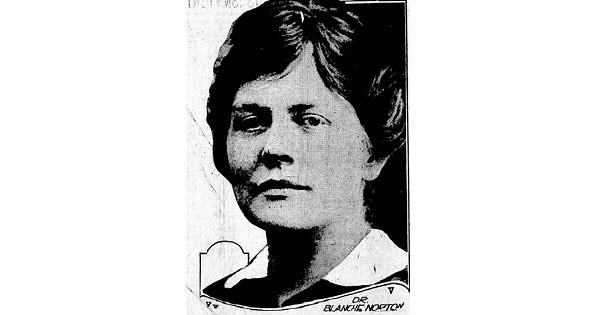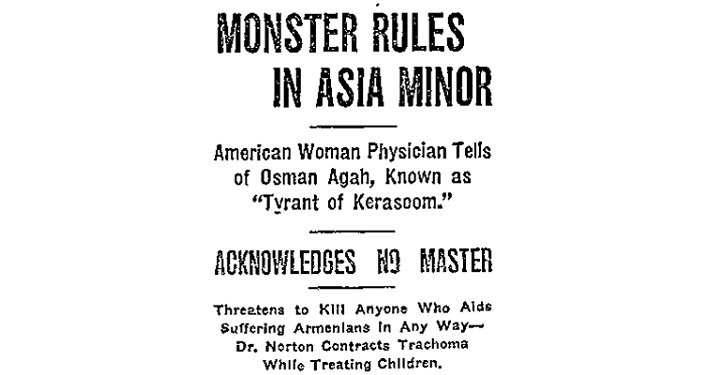
Dr. Blanche Norton of Weehawken, New Jersey departed the USA on June 24, 1919 to join the Near East Relief medical unit in Turkey. By the time she arrived, Turkey had been defeated in World War 1 and the country was overflowing with survivors of the genocides perpetrated by the Ottoman government during the war. Norton attached herself to the Trebizond (Trabzon) unit and began establishing units in the region. She alternated her time working in clinics run by the Greek Red Cross and the Turkish Red Crescent while once a week, she also ran a clinic at nearby Platana.
After five and a half months, she was sent to Giresun where the Near East Relief had two orphanages, an Armenian and a Greek. The Greek orphanage was in terrible condition and was experiencing an acute outbreak of trachoma. Of the 210 children, 50 had been afflicted with the disease which was often complicated with blindness. Norton found so much trachoma that a hospital was later established in Constantinople to treat those affected. She herself caught it and had gone to Constantinople for rest and treatment. The hospital was able to care for 400 Greek and Armenian children at a time.
While treating Greek and Armenian orphans at Giresun, Norton met Osman Agha, the brigand and Kemalist military commander who was responsible for numerous atrocities against Greeks and Armenians in the region. At the time, he was Mayor of the town. She returned to America on September 1920 and not long after her return described him in a news piece. She said:
He is the most fearful creature I ever saw. The native Christians that have so far escaped his wrath live in abject terror of him and of the band of mountain robbers that he has surrounded himself with.
Few Armenians are left in the town. Most of them died of starvation in the streets, with no one to help them. For Osman had promised to have killed immediately anyone who might dare feed or aid them in any way. He has placed oil and gasoline all about the outskirts of the town and had threatened to set it afire and drag all the Greek population to the mountains if allied warships or allied troops attempt to move against him. He is holding the leading Greeks of the city as hostages. No Christian is allowed to leave the city... He is the most absolute tyrant that I believe, has existed since the days of imperial Rome.

Roosevelt Standard, 15 Dec 1920. Accessed 22 Jan 2022. Source: https://newspapers.lib.utah.edu/ark:/87278/s6rz0grn
In an exposé she later wrote about her encounter with Osman Agha, Norton described him in more detail while also expanding on her experience with the orphans she was caring for. She began by describing how upon her arrival at Giresun, she met two orphaned Armenian girls who managed to escape a death march (deportation) by disguising themselves as Turkish women. The girls had escaped to Giresun where they were rescued by a Greek family who risked their own lives by hiding them in their cellar for three years.
Even before arriving at Giresun, Norton heard stories through the Near East Relief at Trebizond about the activities of the Mayor of Giresun. While she was primarily sent to Giresun to work in the Near East Relief orphanage stationed there, she was also sent there to investigate the stories about him. She wrote:
On the day of my arrival I had heard of the Turkish Mayor Osman Agha, and from that day on I never ceased to hear of him. At the Armenian orphanage his name was spoken with nothing short of horror; by the Greeks it was uttered with contemptuous hatred, and by the foreigners, with what seemed facetious comment but showed something very like fearful respect.
She continued:
He was intensely nationalistic and would gladly have swept into oblivion with a wave of his hand, all elements of his nation that were not pure Muslim. He had utter contempt for all European governments, a characteristic at which one can hardly wonder in view of their past and present relation to Turkey.
Shortly after her departure from Giresun, Turkey had been driven out of Europe and had lost territory in Asia Minor to the Allies. The lost land was gven to Greece. As expected, the response from the Kemalist authorities was to persecute the Greeks living within its zones of influence and Osman Agha took this as an opportunity to persecute the local Greeks. As Norton wrote:
Among the first to rebel was Osman Agha, who had already so strengthened his influence that he was ready to take a prominent part in punishing the Greeks of the Black Sea region for the deeds of the Greeks in Europe. His first public act was to arrest the principal Greeks of Kerasund [Giresun] and to shut up the city under the strictest kind of censorship. Greek and British authorities in Constantinople acknowledged their inability to cope with his methods, which included the plan to kill the Greeks, burn the city and flee to the mountains if any interferenbce were tried by foreign elements.
Despite the dangers faced in a Kemalist-controlled area of Turkey and her own anxiety and fears over Osman Agha, Norton worked tirelessly at Giresun. As she herself stated, the most important part of her work there was caring for the Greek orphans. She noted that none of the Greek orphans were natives of the town. When she arrived she found them with bleeding and ulcerated gums, suffering from syphillis and scabies as well as scars from torture. Their heads were hanging listelessly on their breasts, some of them wailing. Their eyes were swollen shut and dripping with pus, suffering the ill-effects of trachoma. Their ages ranged from 4 to 16.
With little help from other medical personell, Norton began the task of caring for the orphans on her own. But after a while, Norton was struck down with trachoma herself, a result of her close contact with the affected orphans. After being transferred to Constantinople for treatment, efforts were made by Greek authorities to send a ship from Constantinople to bring the afflicted children into hospital care. And so, they were rescued and cared for by American doctors and nurses at Constantinople.
In recognition for her service at Giresun caring for the Greek orphans, the Greek government conferred on Blanche Norton the War Cross of King George - the first woman to be honored with the award.
Roosevelt Standard, 15 Dec 1920. Accessed 22 Jan 2022. Source: https://newspapers.lib.utah.edu/ark:/87278/s6rz0grn
Norton, Blanche, The Lame Mayor of Kerasund. Asia: The American Magazine on the Orient. April 1922, pp.285-290, 328.
Dr. Blanche Norton. Near East Museum website. Accessed 22 Jan 2022. https://neareastmuseum.com/memorials/
The Medical Work of the Near East Relief: A Review of its Accomplishments in Asia Minor and the Caucasus during 1919-20. Near East Relief, New York 1923. pp. 35-36.




